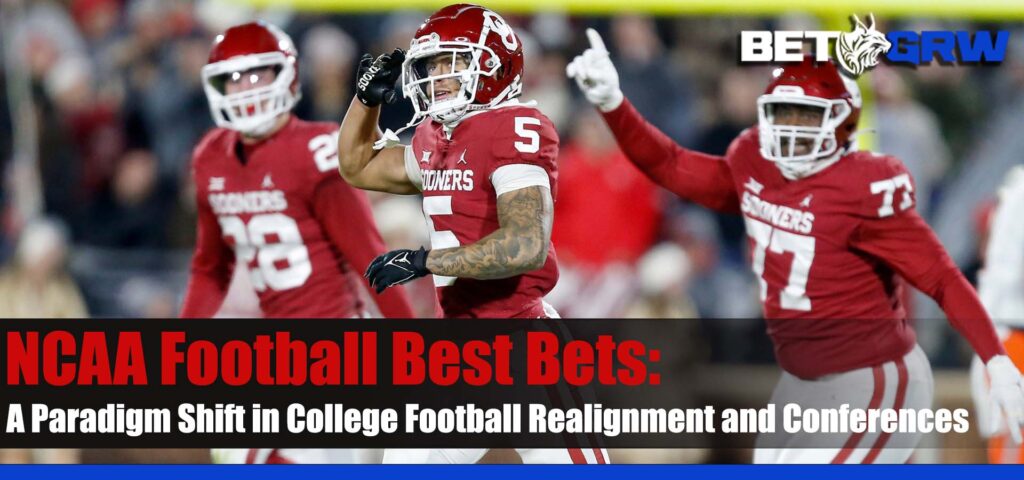
Paradigm Shift in College Football Realignment and Conferences – College football stands to undergo a radical transformation due to the entrepreneurial minds of venture capitalists and private equity firms. A conversation held in December 2022 revealed a groundbreaking idea: the possibility to buy out conferences and fundamentally alter college athletics altogether. Although unrealistic, third-party influence and ownership could profoundly impact meetings and programs. This piece delves deeper into this groundbreaking concept and investigates its possibilities for growth.
Paradigm Shift in College Football Realignment and Conferences: The Billion-Dollar Vision
At a meeting between media consultant Patrick Crakes and venture capitalists, an idea for purchasing and creating a new college football powerhouse emerged. Their plan involved pooling $1 billion to attract four or five teams from each conference – such as Pac-12, Big 12, ACC, or even some Big Ten schools. While still embryonic in its conception, this concept opens up possibilities of unprecedented third-party ownership and influence within college athletics.
Interest from Private Equity Firms
Private equity firms have recently shown great promise in supporting conference structures. Their experience transitioning from traditional investing to sports ventures draws these firms towards college football due to its potential returns, much as other sports, such as professional golf, has seen a similar opportunity presented to them. CBS Sports has learned of at least one major private equity firm showing interest in funding such an endeavor – offering how profound this idea is.
The Changing Landscape of College Athletics
College sports have undergone significant changes over time. Realignment discussions have become more common as conferences seek to strengthen their positions and financial security through realignment initiatives. Current discussions reflect an interest among Power Five meetings for exclusivity and consolidation – perhaps spurred on by the expansion of the College Football Playoff (CFP) with its media rights deal that could further divide having and having-nots, potentially prompting further realignment efforts.
Challenges and Opportunities for Third-Party Ownership
Although third-party ownership in college football offers intriguing prospects, it presents formidable obstacles. One key question involves measuring return on investment: champions won, revenue earned, or both. Additionally, successfully navigating legal and regulatory complications must be managed carefully for this opportunity to work effectively; individuals possessing enough means, motivation, and vision must lead this transformational shift within the college sports landscape.
The Need for Vision and Leadership
College athletics’ critical flaw is its need for more vision and leadership. The NCAA’s resistance to change led to the development of transfer portals and Name, Image, and Likeness (NIL) opportunities – with recent moves by them seeking federal NIL laws as evidence that college sports must adapt or fail. Furthermore, leadership in college athletics is changing, as evidenced by recent appointments of commissioners with backgrounds in TV or media broadcasting deals that highlight their growing significance in shaping college sports’ landscapes.
The Future of College Football
As realignment discussions continue, the future of college football remains to be seen. While third-party involvement and ownership could help reshape its landscape and bring about much-needed stability, consolidation may occur between conferences to form a Power Two consisting of either Big Ten or SEC conferences; ultimately maintaining perceptions that college athletics is inclusive while simultaneously encouraging growth and financial success remains critical challenges facing this sport. While currently at its initial stages of exploration, this revolutionary idea offers insight into the potential future of the sport.
The Impact on Players and Fans
As conversations about third-party ownership and influence evolve, concerns will likely be about its effect on players and fans. Critics may fear that such a transformation would further distance college football from its origins – where student-athletes represent their institutions while fan passion drives its spirit – ensuring student welfare remains top of mind will be essential in successfully navigating this unfamiliar terrain.
At present, college sports are witnessing an initial stage of discussion regarding third-party influence in college football. College football may soon experience a seismic transformation as venture capitalists and private equity firms show greater interest in investing in college sports. Acceptance of change and visionary leadership is crucial to ensure long-term survival and prosperity. As third-party ownership becomes an increasing reality in college football, it becomes imperative for its community to engage in careful reflection and joint efforts. Redefining conferences and programs may also cause changes, ultimately depending on those willing to innovate and break with conventional wisdom. Navigating this unpredictable road requires adaptability and courage when exploring potential new avenues that benefit college sports updates in Canada.














